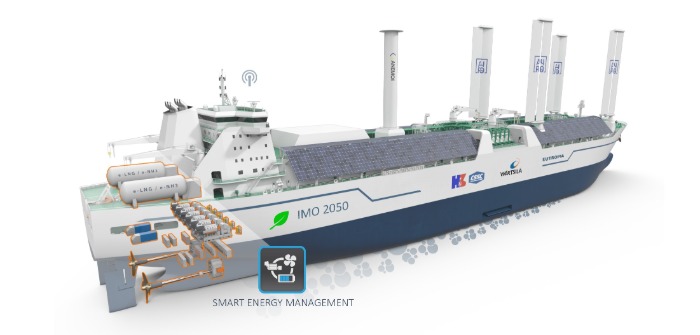ABS, Hudong-Zhonghua Shipbuilding (HZS) and Wärtsilä have announced a partnership to carry out a collaborative development of a future-ready, flexible, modular, multi-fuel electric liquefied natural gas carrier (LNGC) vessel.
Using multi-physics and simulation technology, the group will apply a range of decarbonization design efforts, solutions and operation models to investigate and ensure that the vessel’s performance meets the International Maritime Organization’s (IMO) Carbon Intensity Indicator (CII) requirements until 2050 at the very least.
Optimized around a compact, electrified, integrated and efficient propulsion power solution, the LNGC’s flexible design is expected to deliver reductions in CO2 levels. The futureproofed ship ensures that emerging technologies can be efficiently integrated later to keep the vessel ahead of CII requirements and changes in legislation.
“The evolving demands of the CII mean vessels will need to be ready to continuously improve their efficiency rating to remain viable for the duration of their operational life,” commented Patrick Ryan, senior vice president of global engineering and technology at ABS. “Advanced multi-physics modeling and simulation techniques enable development of a vessel with a strong CII profile at launch that is also equipped to take advantage of future decarbonization technologies as they mature. ABS is a leader in the application of multi-physics modeling and simulation at sea, and we are excited about the potential of this technology to drive shipping’s decarbonization ambitions and meet IMO 2050 objectives.”
“We are very glad to closely work together with Wärtsilä and ABS to develop the new generation of LNG carriers that offer a low-carbon footprint and low opex cost,” said Song Wei, R&D deputy director at Hudong-Zhonghua Shipbuilding. “This state-of-the-art hybrid solution will be developed to power the future LNG carrier, enabling dual-fuel engines running always at best efficiency and providing flexible power supply modes to adapt to various load demands.”
At present, shipowners face challenges when attempting to plan fleets that can meet the IMO’s Carbon Intensity Index (CII) carbon reduction trajectory of minus 70% by 2050. Companies are achieving this by futureproofing new-build vessels that can accommodate new or updated vessel speed and voyage optimizations in the future.
“The modular and hybridized nature of this smart propulsion system provides the correct foundation for the introduction of new and potentially highly intermittent low-carbon energy sources and propulsion-energy-saving devices both in the new-build phase and also later as potential retrofit solutions. We are honored that ABS and Hudong-Zhonghua have invited us to contribute to the development of this new LNGC design that will leverage ABS’s long experience in LNGC development and simulation expertise as well as Hudong-Zhonghua’s rich design and construction experience of large LNGCs,” said Stefan Nysjö, vice president of power supply at Wärtsilä Marine Power.



